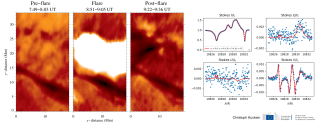Grants related:
General
The search for life in the universe has been driven by recent discoveries of planets around other stars (known as exoplanets), becoming one of the most active fields in modern astrophysics. The growing number of new exoplanets discovered in recent years and the recent advance on the study of their atmospheres are not only providing new valuable information about its physical properties, but also allowing to constrain the properties of the Solar system's planets within a more global context. The field is approaching to the important discovery of the first potentially habitable planets and encouraging more detailed studies of them. With the launching of upcoming related satellites like JWST, CHEOPS, TESS, ARIEL and PLATO, the exoplanets field faces a bright future.
It is for this reason that this field is aid of, and at the same time promotes, the development of increasingly sensitive and stable instrumentation for both, ground-based telescopes and space missions. Our group is particularly prepared for these two fronts. On the one hand, during the last years we have developed observational and reduction techniques of exoplanet transits data for the ORM telescopes, ours being one of the most productive groups in the exploitation of GTC. On the other hand, all ESA space missions (present and future) related to exoplanets have one or more components of the project as CoIs. Within the frame of this project, we intend that IAC researchers maintain an advantageous position regarding the operation of OSIRIS and CanariCam, first light
GTC's instruments, and participate in the construction, commissioning and operation of new instruments such as the high resolution optical spectrograph HORUS at GTC. The exploitation of the photometry and spectroscopy of transits with LIRIS at WHT is also one of our principal interests, especially in preparation for the installation in 2015 of EMIR on the GTC .
To summarize, the project "Exoplanets and Astrobiology" will focus on these four action lines:
1) The characterization of atmospheric and physical properties of exoplanets (GTC, WHT, ARIEL, HARPSN, CARMENES, ESPRESSO, etc. ..)
2) The search and confirmation of exoplanets by transits techniques (CoRoT, Kepler, K2, CHEOPS, XO, LCOGT, W FC, DISH, etc. ..)
3) The search and confirmation of exoplanet by radial velocity techniques (HARPSN, HORUS, LCOGT, SONG, CARMENES)
4) Astrobiology
Members
Results
- Detection of He in the atmosphere of an exoplanet from the ground, published in Science
- Detection of a super-earth around Barnard star, published in Nature
- Detection of the first TESS planets, with several papers of high relevance
- Discovery of Na and Halpha features in the spectrum of KELT-20b with TNG
- Publication of the Handbook of Exoplanets, the most extensive work of reference in the field of exoplanets. The Handbook was edited by members of our group, and includes contributions by about 300 experts worldwide, including 12 members of IAC.
Scientific activity
Related publications
-
A Radial Velocity Study of the Planetary System of π Mensae: Improved Planet Parameters for π Mensae c and a Third Planet on a 125 Day Orbit
π Men hosts a transiting planet detected by the Transiting Exoplanet Survey Satellite space mission and an outer planet in a 5.7 yr orbit discovered by radial velocity (RV) surveys. We studied this system using new RV measurements taken with the HARPS spectrograph on ESO's 3.6 m telescope, as well as archival data. We constrain the stellar RV
Hatzes, Artie P. et al.Advertised on:
52022 -
Radio emission in a nearby, ultra-cool dwarf binary: A multifrequency study
Context. The substellar triple system VHS J125601.92−125723.9 (hereafter VHS 1256−1257) is composed of an equal-mass M7.5 brown dwarf binary and an L7 low-mass substellar object. In Guirado et al. (2018, A&A, 610, A23) we published the detection of radio emission at 8.4 GHz coming from the central binary and making it an excellent target for
Climent, J. B. et al.Advertised on:
42022 -
A Possible Alignment Between the Orbits of Planetary Systems and their Visual Binary Companions
Astronomers do not have a complete picture of the effects of wide-binary companions (semimajor axes greater than 100 au) on the formation and evolution of exoplanets. We investigate these effects using new data from Gaia Early Data Release 3 and the Transiting Exoplanet Survey Satellite mission to characterize wide-binary systems with transiting
Christian, Sam et al.Advertised on:
52022 -
CaRM: Exploring the chromatic Rossiter-McLaughlin effect. The cases of HD 189733b and WASP-127b
Aims: In this paper we introduce CaRM, a semi-automatic code for the retrieval of broadband transmission spectra of transiting planets through the chromatic Rossiter-McLaughlin method. We applied it to HARPS and ESPRESSO observations of two exoplanets to retrieve the transmission spectrum and we analyze its fitting transmission models. Methods: We
Cristo, E. et al.Advertised on:
42022 -
Investigation of the upper atmosphere in ultra-hot Jupiter WASP-76 b with high-resolution spectroscopy
Alkali metal lines are one of the most important key opacity sources for understanding exoplanetary atmospheres because the Na I resonance doublets are thought to be the cause of low albedo, as the alkali metal's wide line wings absorb almost all of the incoming stellar irradiation. High-resolution transmission spectroscopy of Na absorption lines
Kawauchi, Kiyoe et al.Advertised on:
42022 -
Nodal precession of WASP-33b for 11 yr by Doppler tomographic and transit photometric observations
WASP-33b, a hot Jupiter around a hot star, is a rare system in which nodal precession has been discovered. We updated the model for the nodal precession of WASP-33b by adding new observational points. Consequently, we found a motion of the nodal precession spanning 11 yr. We present homogenous Doppler tomographic analyses of eight data sets
Watanabe, Noriharu et al.Advertised on:
52022 -
Black Mirror: The impact of rotational broadening on the search for reflected light from 51 Pegasi b with high resolution spectroscopy
Context. The extreme contrast ratios between stars and their planets at optical wavelengths make it challenging to isolate the light reflected by exoplanet atmospheres. Yet, these reflective properties reveal key processes occurring in the atmospheres, and they also span wavelengths that include the potential O 2 biosignature. High resolution cross
Spring, E. F. et al.Advertised on:
32022 -
A Second Planet Transiting LTT 1445A and a Determination of the Masses of Both Worlds
LTT 1445 is a hierarchical triple M-dwarf star system located at a distance of 6.86 pc. The primary star LTT 1445A (0.257 M ⊙) is known to host the transiting planet LTT 1445Ab with an orbital period of 5.36 days, making it the second-closest known transiting exoplanet system, and the closest one for which the host is an M dwarf. Using Transiting
Winters, Jennifer G. et al.Advertised on:
42022 -
Moderately misaligned orbit of the warm sub-Saturn HD 332231 b
Measurements of exoplanetary orbital obliquity angles for different classes of planets are an essential tool in testing various planet formation theories. Measurements for those transiting planets on relatively large orbital periods (P > 10 d) present a rather difficult observational challenge. Here we present the obliquity measurement for the warm
Sedaghati, E. et al.Advertised on:
32022 -
Transit timing variations of AU Microscopii b and c
Here we report large-amplitude transit timing variations (TTVs) for AU Microcopii b and c as detected in combined TESS (2018, 2020) and CHEOPS (2020, 2021) transit observations. AU Mic is a young planetary system with a debris disk and two transiting warm Neptunes. A TTV on the order of several minutes was previously reported for AU Mic b, which
Szabó, Gy. M. et al.Advertised on:
32022 -
The atmosphere and architecture of WASP-189 b probed by its CHEOPS phase curve
Context. Gas giants orbiting close to hot and massive early-type stars can reach dayside temperatures that are comparable to those of the coldest stars. These `ultra-hot Jupiters' have atmospheres made of ions and atomic species from molecular dissociation and feature strong day-to-night temperature gradients. Photometric observations at different
Deline, A. et al.Advertised on:
32022 -
A tentative detection of He I in the atmosphere of GJ 1214 b
The He I λ10833 Å triplet is a powerful tool for characterising the upper atmosphere of exoplanets and tracing possible mass loss. Here, we analysed one transit of GJ 1214 b observed with the CARMENES high-resolution spectrograph to study its atmosphere via transmission spectroscopy around the He I triplet. Although previous studies using lower
Orell-Miquel, J. et al.Advertised on:
32022 -
Metallicities in M dwarfs: Investigating different determination techniques
Deriving metallicities for solar-like stars follows well-established methods, but for cooler stars such as M dwarfs, the determination is much more complicated due to forests of molecular lines that are present. Several methods have been developed in recent years to determine accurate stellar parameters for these cool stars (T eff ≲ 4000 K)
Passegger, V. M. et al.Advertised on:
22022 -
CHEOPS geometric albedo of the hot Jupiter HD 209458 b
We report the detection of the secondary eclipse of the hot Jupiter HD 209458 b in optical/visible light using the CHEOPS space telescope. Our measurement of 20.4 −3.3 +3.2 parts per million translates into a geometric albedo of A g = 0.096 ± 0.016. The previously estimated dayside temperature of about 1500 K implies that our geometric albedo
Brandeker, A. et al.Advertised on:
32022 -
Detection of iron emission lines and a temperature inversion on the dayside of the ultra-hot Jupiter KELT-20b
Ultra-hot Jupiters (UHJs) are gas giants with very high equilibrium temperatures. In recent years, multiple chemical species, including various atoms and ions, have been discovered in their atmospheres. Most of these observations have been performed with transmission spectroscopy, although UHJs are also ideal targets for emission spectroscopy due
Yan, F. et al.Advertised on:
32022 -
HD 207897 b: A dense sub-Neptune transiting a nearby and bright K-type star
We present the discovery and characterization of a transiting sub-Neptune that orbits the nearby (28 pc) and bright (V = 8.37) K0V star HD 207897 (TOI-1611) with a 16.20-day period. This discovery is based on photometric measurements from the Transiting Exoplanet Survey Satellite mission and radial velocity (RV) observations from the SOPHIE
Heidari, N. et al.Advertised on:
22022 -
Discovery and mass measurement of the hot, transiting, Earth-sized planet, GJ 3929 b
We report the discovery of GJ 3929 b, a hot Earth-sized planet orbiting the nearby M3.5 V dwarf star, GJ 3929 (G 180-18, TOI-2013). Joint modelling of photometric observations from TESS sectors 24 and 25 together with 73 spectroscopic observations from CARMENES and follow-up transit observations from SAINT-EX, LCOGT, and OSN yields a planet radius
Kemmer, J. et al.Advertised on:
32022 -
Investigating the architecture and internal structure of the TOI-561 system planets with CHEOPS, HARPS-N, and TESS
We present a precise characterization of the TOI-561 planetary system obtained by combining previously published data with TESS and CHEOPS photometry, and a new set of 62 HARPS-N radial velocities (RVs). Our joint analysis confirms the presence of four transiting planets, namely TOI-561 b (P = 0.45 d, R = 1.42 R ⊕, M = 2.0 M ⊕), c (P = 10.78 d, R =
Lacedelli, G. et al.Advertised on:
42022 -
NEID Rossiter-McLaughlin Measurement of TOI-1268b: A Young Warm Saturn Aligned with Its Cool Host Star
Close-in gas giants present a surprising range of stellar obliquity, the angle between a planet's orbital axis and its host star's spin axis. It is unclear whether the obliquities reflect the planets' dynamical history (e.g., aligned for in situ formation or disk migration versus misaligned for high-eccentricity tidal migration) or whether other
Dong, Jiayin et al.Advertised on:
22022 -
A multi-planetary system orbiting the early-M dwarf TOI-1238
Context. The number of super-Earth and Earth-mass planet discoveries has increased significantly in the last two decades thanks to the Doppler radial velocity and planetary transit observing techniques. Either technique can detect planet candidates on its own, but the power of a combined photometric and spectroscopic analysis is unique for an
González-Álvarez, E. et al.Advertised on:
22022



